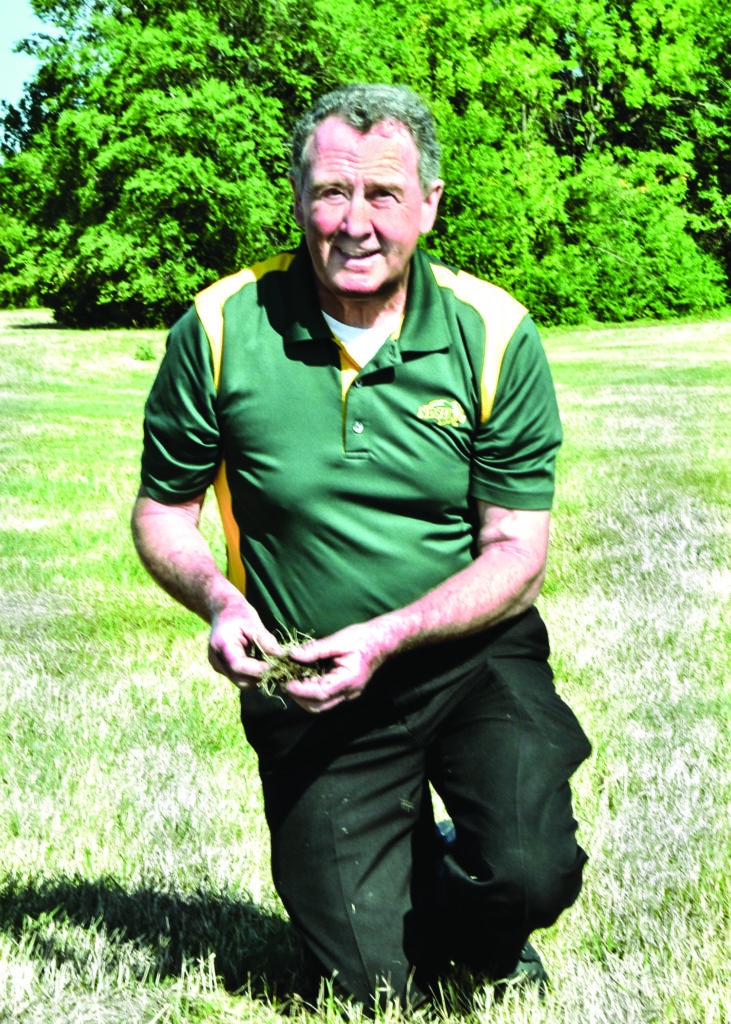
NDSU Extension horticulturist Don Kinzler says these are crucial days for heat- and drought-stressed lawns. If the rains don’t come, homeowners need to water generously. Photos/Russ Hanson.
Nancy Edmonds Hanson
These are not the best of times, if you’re a lawn. You’ve struggled through long stretches of 90-degree days. You’ve gone months without a good drink until sips in the past few days. You’ve drawn down your savings account of stored resources trying to maintain the long green. And you’re just about broke.
That’s the state of the Kentucky bluegrass that populates yards in our part of the world. North Dakota State University extension horticulturist Don Kinzler says the crunchy brown cover that’s replaced many lush landscapes this summer is the last survival trick in its book – going dormant to await better, wetter days.
Dormant – that brown and crunchy state – is not dead. Instead of “spending” scant resources on staying green above ground, the grass marshals what remains to keep the roots and crown alive.
“But we may be nearing the point of no return,” he said last week. “What happens if we don’t get regular fall rain? If the lawn goes into winter dormant, it may not come back in the spring.”
We talked before the reprieve offered by weekend rain, in which Moorhead received an inch or two of grass-saving moisture. It brought big smiles to the faces of homeowners who have limited or stopped watering to conserve water.
But that temporary relief is far, far from a cure. It takes more than one good shot of precipitation to bring the brown, crinkly, dormant stuff back to life. Depending on forecasts for the rest of the fall, stressed lawns could still repeat the outcome of the most recent drought in 1988, when many did not make it back the next spring. Based on that fact, Don emphasizes, lawns should not be allowed to go into winter dormant.
“In fall, lawns have to replenish their energy by growing again,” he advises. “When they’re dormant, as they are right now, they’re hibernating … but still alive. They’re survivng on their stored energy.
“They must be awakened. To do that, you need moisture. One inch a week is ideal to keep your lawn healthy. Even half an inch would do.”
That’s not usually a major concern. In a typical year, fall rains soak grass that’s not nearly as stressed as 2021’s crop. This year, though, even with this week’s hint of damper days ahead … homeowners can’t count on it.
“So we have to piggyback on what nature gives us,” the horticulturist advises. “From now until the end of the season, we need to supplement whatever rain falls with sprinkling. Grass really needs that inch a week to get active again and woken up.”
Don recommends long, deep soaking once a week. That means getting up early or staying up late to observe Moorhead’s Phase Two watering restrictions, which just went into effect. Earlier this summer, they requested homeowners water lawns only on even or odd days corresponding with their house numbers. Now, as the Red River’s level drops even farther, the mandate has been reduced to just one day a week, this time on the same day as garbage pick-up. But it’s even tighter than that: If your bins are emptied on Friday, for example, you may water during two periods that day – from midnight to 8 a.m., and again from 8 p.m. to midnight.
How do you know if your grass is drinking enough? Don suggests going low tech: Set out a tuna fish or soup can, then measuring what falls into it.
What if you decide to sleep in instead of getting up to turn sprinklers on and off in the middle of the night, and a stingy Mother Nature denies us rain into the winter?
“Then we’re in trouble. I’d expect many dead or drastically thin lawns next spring, especially if there’s not much snow. If we can’t replenish this fall, they’ll go into the winter essentially dead.”
Normally thin patches could be over-seeded in the fall to thicken the lawn next spring. Because of the drought, however, that’s not being recommended. “If the fall is hot and dry, seed won’t germinate,” Don cautions. “Assess the damage now, but wait until spring.”
Adding one more blow, he notes that weeds don’t suffer like the grass does. They’re having a heyday. “They generally have much deeper root systems,” he points out. “That just adds another element to the problems and further damages the turf.”
This summer has challenged area lawns more viciously than any other in the past 30-plus years. But is there a silver lining somewhere in the cloudless sky?
Don pauses to think. “Well,” he finally replies, “we haven’t seen too many mosquitoes.”


